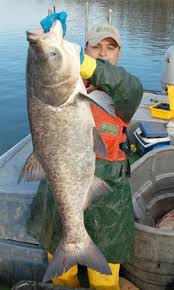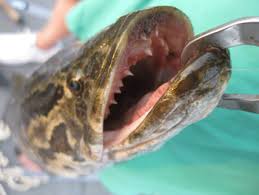Non-Native, Invasive Species for Dinner? Bring Out the Melted Butter!
By Marcia Anderson
Recently, I discovered some really tasty invasive species on the dinner menu in lower Manhattan. Many non-native species can be really good eating if they can be caught and properly prepared. There is an innovative movement for eating invasive species taking place and they are showing up more and more on restaurant menus.
In 2014, 350 chefs and culinary professionals attended the 6th Annual Chefs Collaborative Summit in Boulder, Colorado. They collaborated on how to incorporate invasive species into menus, among other topics.
Consumption is not a quick fix or silver bullet for the problem of invasive species, but along with integrating other management measures, we could all be part of the solution. There is growing evidence that systematic removal of invasive species can be effective and that native species can recover if populations of invasive species are reduced. Invasive species are one of the top drivers of biodiversity loss, and there are plenty of recorded extinctions because of them.
How about Asian carp fritters as an appetizer or lionfish tacos?
Asian carp are a delicacy in China and are threatened in the Yangtze River. Asian carp include four different species – the silver, bighead, grass, and black carp. These fish were brought to the United States primarily by catfish farmers in the 1970s to control algal blooms in aquaculture ponds. They are voracious eaters in dozens of waterways including the Mississippi River and some tributaries. Because they compete with some native fish, they are throwing off the local ecosystem balance.
Lionfish (Pterois volitans) was on the menu in a restaurant on Manhattan’s Lower East Side and found in many other US restaurants. It tastes like snapper or flounder and is light, fluffy, mild, and easy on the palette. The fact that it is not fishy keeps it on the menu. Lionfish are voracious predators of small fish and
crustaceans, eating multiple small fish per hour. They are decimating Caribbean island coral reefs, mangrove swamps and sea grass meadows. Their long, venomous spines are deadly to many would-be predators. Lionfish tacos are just one variation found on some Mexican restaurant menus. The conservative organization REEF produced The Lionfish Cookbook.
Years ago, I had my first taste of wild boar (Sus scrofa), or Eurasian wild pig, in New York City. The tenderloins actually tasted better than pork from farm raised pigs. In the wild, boars are ravenous and will eat almost anything, often causing massive erosion. They are dangerous to hunt or even be in close proximity to, as they will bite livestock, pets and children. Ecologically disastrous, wild boar are estimated to cost the Texas economy alone about $52 million in agricultural damage each year, according to Texas A&M University. The University of Georgia chapter of the Society of Conservation Biology regularly sponsors an annual Invasive Species Hog Roast to heighten awareness of the problem.
The Northern snakehead (Channa argus) is considered a delicacy in Chinese and Thai cultures and they really taste like chicken. A native of Asia, the snakehead is scaly, sharp-toothed, and gill fish that has the head of a snake and the body of a fish, which will eat virtually anything in its path, even taking a
bite out of unsuspecting bathers. More people across the US have decided to bite them before they bite us. The northern snakehead is known to the residents of Maryland as a potential ecological threat. Local fish markets sell whole, frozen snakeheads to restaurants and the public. There has been interest expressed in adding the snakehead to the U.S. list of injurious wildlife.
The invasive giant tiger prawn (Penaeus monodon) is a delicious crustacean that can grow to be a foot or more long. Just think shrimp on steroids! Their pleasantly sweet taste is why mariculture farmers brought the prawns to the northern Gulf of Mexico from the coasts of Australia and southeast Asia. It is highly likely that the prawns may have started their Gulf invasion after escaping from an aquaculture operation or after hurricanes Katrina or Rita in 2005. Tiger prawn are voracious predators, have become a threat to local crab, shrimp and oyster markets and potentially could spread shellfish diseases to native species. The Louisiana Department of Wildlife and Fisheries has advised fisherman that, when caught, these prawns should not be thrown back into any open waters. Either sell them, as they can fetch a higher price than many other shrimp, or throw them in a pot of boiling water for dinner.
American lakes, rivers and offshore waters are filling with destructive fish and crustaceans from other parts of the world that are wreaking havoc on fragile ecosystems. The good news is that many of them are potentially good food sources. Successful and sustained removal will require creative strategies that mobilize a range of stakeholders from consumers to industry.
For more on eating invasive species, go to the University of Vermont Gund Institute’s Eat the Invaders Facebook forum. Read more on what you can do to help manage invasive species from the US Fish and Wildlife Service.
About the Author: Marcia is with EPA’s Center of Expertise for School IPM in Dallas, Texas. She holds a PhD in Environmental Management from Montclair State University along with degrees in Biology, Environmental Design, Landscape Architecture, and Instruction and Curriculum. Marcia was formerly with the EPA Region 2 Pesticides Program and has been a professor of Earth and Environmental Studies, Geology, and Oceanography at several universities.




Oct 24, 2016 @ 10:08:49
THE lOBSTER IN ATLANTIC CANADA WAS ONCE CONSIDERED A NUISANCE SPECIES AND IS NOW A VERY LUCRATIVE FISHERY.